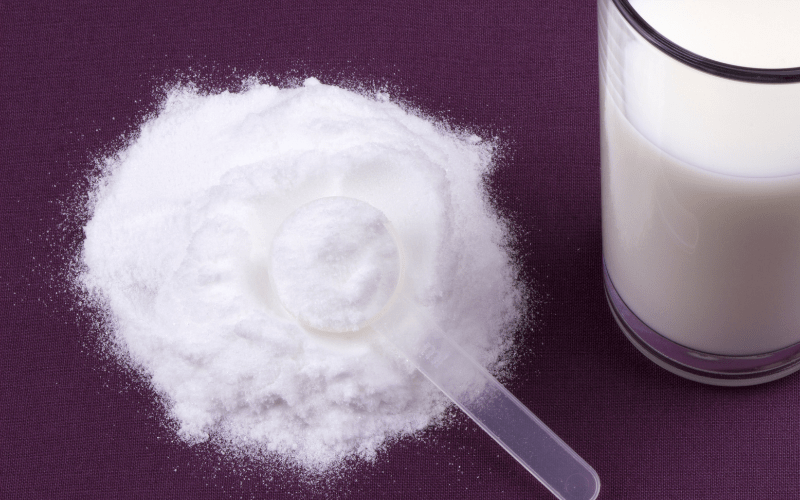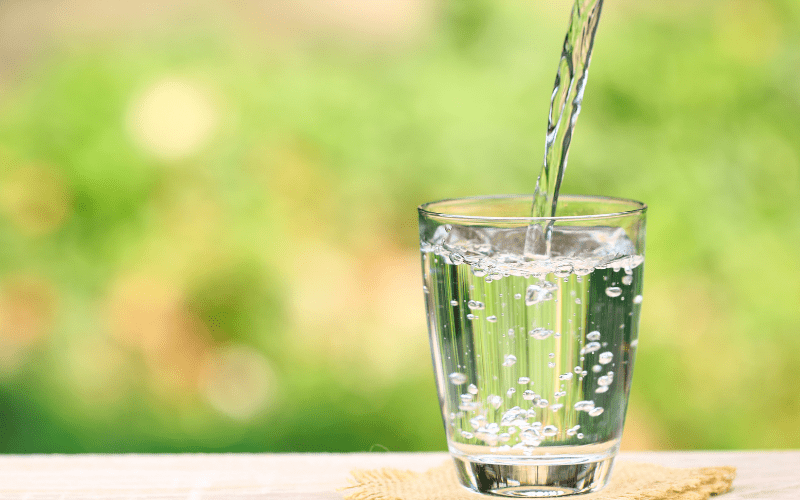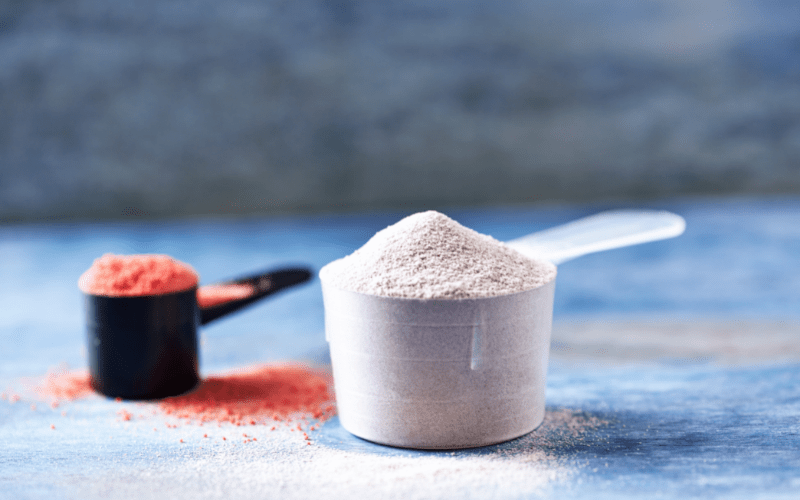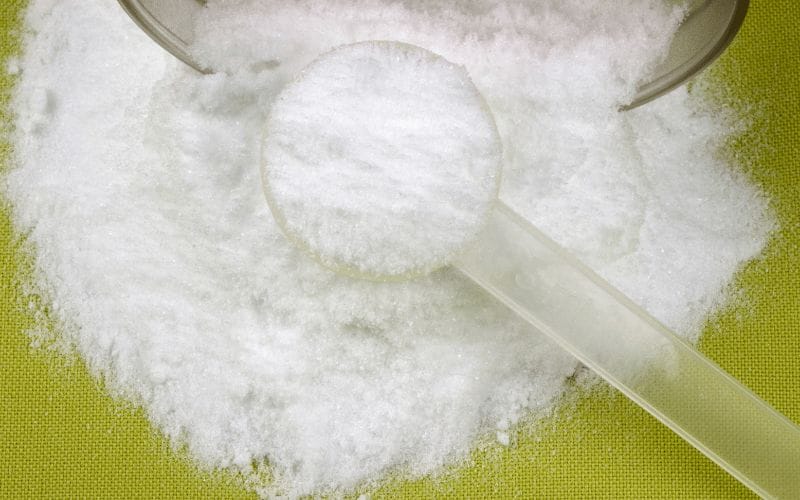Creatine supplements come in various forms including pills or capsules, liquid creatine, and creatine powder. The most common form is probably powder and this can resemble protein powders and other pre-workout or supplemental powders.

If you choose a powdered form of creatine to introduce into your diet and exercise regimen, you’ll need to learn the best way to mix it to ensure it is as easy as possible to drink and digest.
Although some people like to mix creatine powder with milk in order to give a more shake-like consistency, the most widely preferred option is probably just to stick to mixing it with water.
This article will look at how much water to use to achieve the best creatine mixture consistency, the advantages of using water, and how creatine relates to water in bodily processes.
By the time you’ve finished reading, you should feel more confident to buy and mix your own creatine powder so you can get well on your way to achieving your physical performance goals!
Without further ado, let’s get into it!
Creatine supplementation in powder form is easily the most common amongst body builders, weightlifters, and athletes as the powder generally comes in large tubs and you only require small amounts at a time to get sufficient creatine levels for your workouts.
The amount of powder you’re recommended to take may differ depending on your physical attributes such as height and weight, sex, and taking into consideration your workout goals, frequency, and intensity. Most good creatine supplements should have a dosage guide on their label to advise on how much powder to use.
Similarly, a lot of powders will also have a guide for how much water to mix with the powder, however this is not as important as how much powder you ingest. The main thing to keep in mind is that the mixture should be liquid and easily drinkable.
Most creatine powders will go through a certain amount of denaturing as soon as they’re mixed with water, so you need to be able to drink the mixture as quickly as possible.
Most creatine powders will have a spoon or scoop inside the tub to help you with measuring, so depending on how much powder is recommended for your physical circumstances, quickly mixing a scoop (or other appropriate amount) into a glass of water should do the trick.
Mixing creatine with water is simply one of the easiest ways to make the powder drinkable and it’s also inexpensive and easily accessible. There’s also very little chance of your body having an adverse reaction to drinking creatine mixed with water.

That said, many people like to mix creatine powder with other things including milk (either dairy or plant-based alternatives) or even fruit juice for a sweeter drink.
Most creatine powders are not formulated with taste in mind, so creatine supplementation using only water might not be the most tempting of options. In most cases, mixing creatine with juice is completely fine, although if he label of your powder advises against this, you should heed this advice.
If you’re mixing with milk and fancy a consistency more akin to a workout shake, then you can consider using less liquid than you might with water, and if you shake the mixture instead of just stirring it, the milk should froth up a bit to give you a thicker consistency.
Where milk is concerned, you might need to just be aware of possible digestive issues, particularly if you have an already sensitive digestive system, as creatine and milk both have the potential to cause bloating. When mixed together, that risk is increased slightly.
Creatine has never been proven to be directly responsible for bloating and other digestive issues, however in sensitive individuals, taking in large amounts of creatine can become irritating and lead to digestive problems.
Creatine in itself is not a high FODMAP ingredient, however when mixed with milk, it can contribute to stomach troubles including bloating. If you feel you might be susceptible to these kinds of problems, then stick to a classic water mixture.
If you’ve been looking into starting creatine supplementation, you may have come across the term “creatine loading phase”. What does this mean? Is it necessary?

A creatine loading phase is not always necessary and will depend on what your current muscular and physical capabilities are as well as what your goals are. However, most people in the body building and weight lifting spheres find that a loading phase provides the best possible start for their muscle building journey.
Depending on your body weight and other characteristics, the creatine loading phase usually involves taking between 20 and 25g of creatine per day for 5 to 7 consecutive days. This is commonly broken down into several daily doses of 5g each or similar. Remember to consult a doctor prior to beginning creatine loading, just to be on the safe side.
During the loading phase, you’re essentially jumpstarting your body’s ability to process and assimilate creatine by introducing it with larger doses.
Whilst creatine loading can be done with basically any type of creatine powder, there are definitely some types that will suit different people better.
Creatine monohydrate is the most common and generally most effective form of powdered creatine and is also the type that has been studied and trialled most rigorously. Creatine monohydrate is also widely accepted as one of the most easily soluble forms which makes it great for loading as the higher doses are easily dissolved in water and more easily digested.
Micronized creatine is a better option yet as it is essentially the same thing as creatine monohydrate but in a finer powder, making it even more soluble and much better creatine absorption by the body. As a general rule, creatine powders dissolve more easily in warm water and this is true for micronized creatine too.
After a few days of taking a higher dose of creatine, you can then start to taper off your loading so that you begin taking less creatine per day. These smaller doses are often referred to as maintenance doses and they typically involve taking 3-5g of creatine per day instead of the loading amount of 20-25g.

Another way to measure the maintenance dose is to calculate 0.01g per pound of body weight per day, and this will help your body to remain at optimal strength and stamina as you continue to work out.
During the loading phase, people are sometimes shocked to find that they’ve put on weight however this is not due to increased levels of fat and is actually down to water redirection and retention in muscles which you can read more about here.
This weight gain will likely continue as you move into the maintenance phase of creatine use, however this will be because you are building more muscle mass.
There’s a common misconception that creatine is a dehydrating substance but there is no scientific evidence to support this theory. Creatine helps muscle cells to draw in water in order to stay hydrated during intense physical activity, improving overall exercise performance.
This movement of water into the muscles is essentially negligible in terms of having a dehydrating effect to other parts of the body. As such, you should be drinking as much water as you would normally when doing an intense workout.
Because creatine promotes increased ATP production which supplies more energy to muscles, and therefore allows you to workout harder and longer, you may require more water to stay hydrated if working out for a sustained period, but your body will be able to tell you what it needs.
Signs of dehydration include:
When working out in conjunction with creatine supplementation, just as when working out without creatine, you need to replace the liquid your body loses through sweating. If you work out harder and therefore sweat more, you’ll need to drink more to replenish this loss.

Aside from replacing what water you lose during workouts, you shouldn’t need to increase how many glasses of water you drink per day.
Although creatine itself will not dehydrate you, it can be easy to forget when working out a lot that there are other substances that will.
It can be really tempting after a heavy workout or gym session to grab an iced coffee or other caffeinated beverage to help you get an energy boost after all the exertion. However, it’s really important to avoid caffeine before, during, and after working out as caffeine acts as a diuretic.
A diuretic is a substance that works to flush your body of excess water through your kidneys. Coffee and fizzy drinks cannot tell how much water your body will need so drinking them after working out when you’ve been sweating a lot and therefore losing a lot of water can be quite dangerous.
In short, diuretics can have dehydrating effects if you ingest them whilst or directly after working out. You need to make sure you’ve given your body enough water to replace what it lost through sweating before grabbing that frappacino. An electrolyte-containing energy drink can also help with rehydration so is an effective post workout drink.
The same goes for alcohol. Frequent alcohol consumption can hinder creatine’s ability to assist your body with improving athletic performance by drawing water away from tissues and flushing it through your kidneys. It can also damage your organs and muscle cells, making them less effective in the long run.
At the end of the day, the amount of water you mix with your creatine dose is not that important. What is important is that you make every effort to remain hydrated whilst pushing your body’s athletic limits.
Increased training time and higher intensity workouts are exactly what you need to aim for when taking creating, but with the greater effort also comes a greater potential for dehydration, which is why it’s important to drink lots of water.
Alongside your supplement use, water intake, and exercise, a balanced and healthy diet is also a cornerstone for a healthy body and lifestyle so don’t forget to put effort into your meals too!